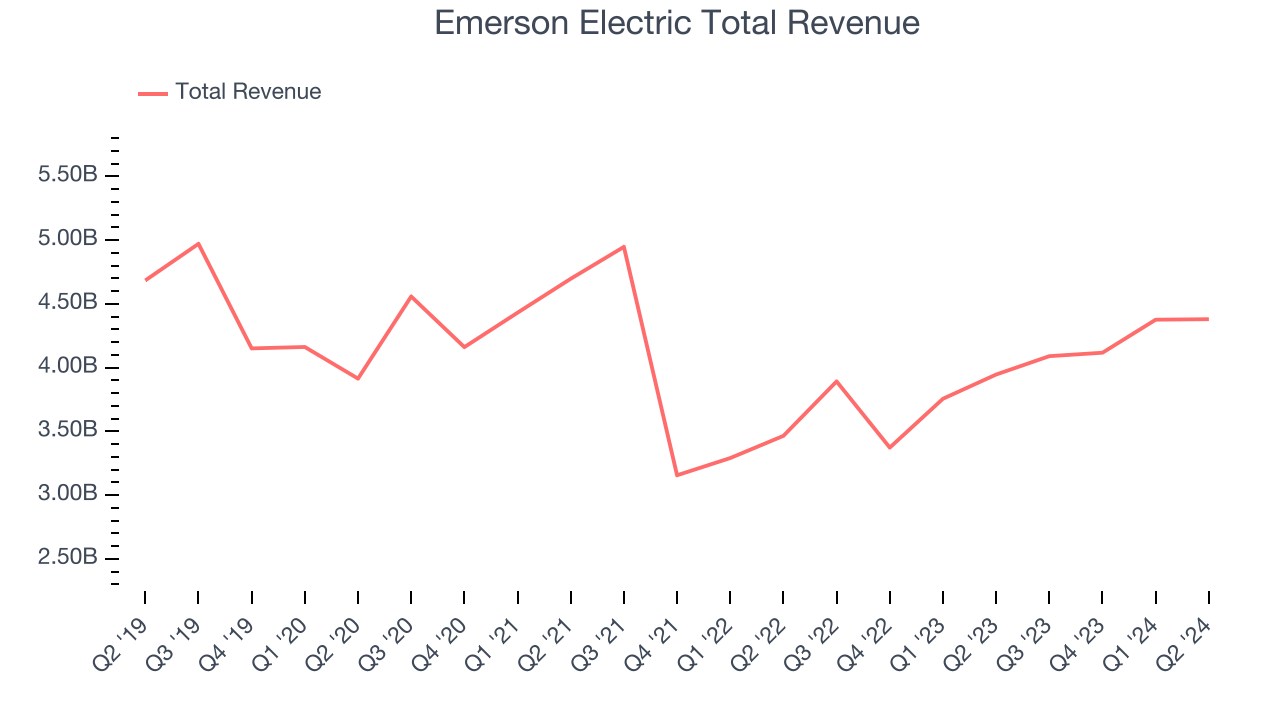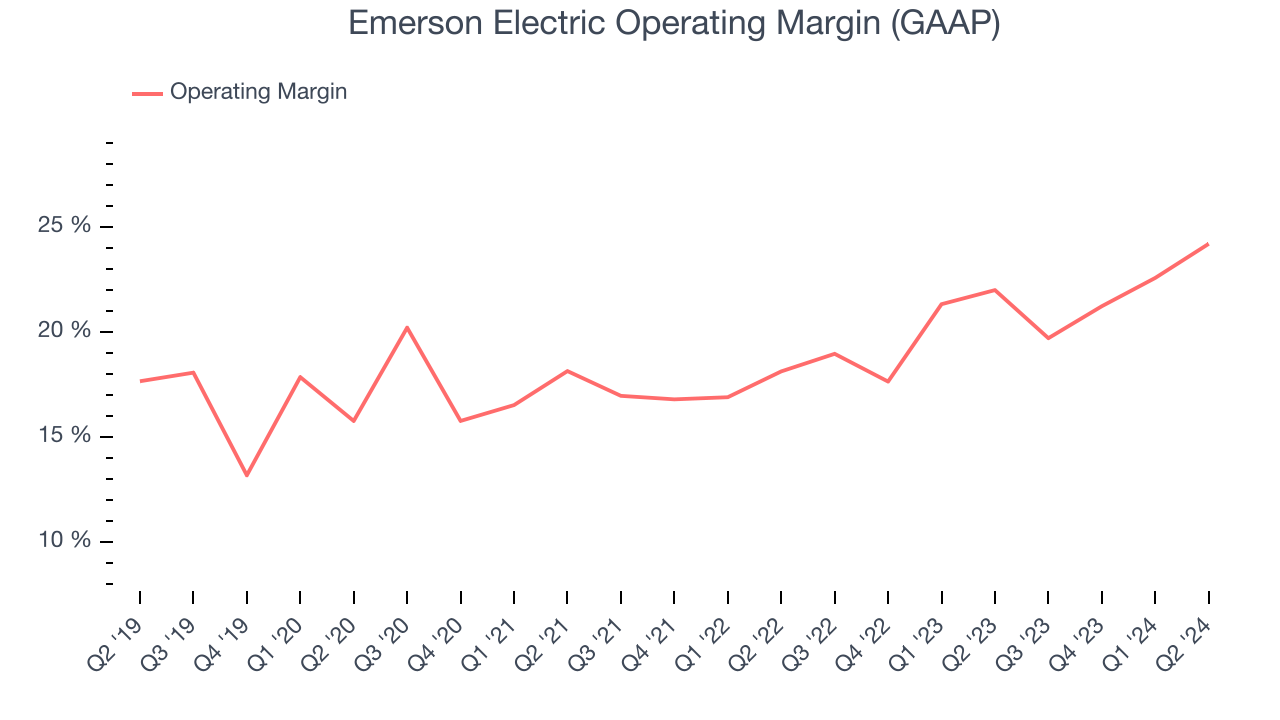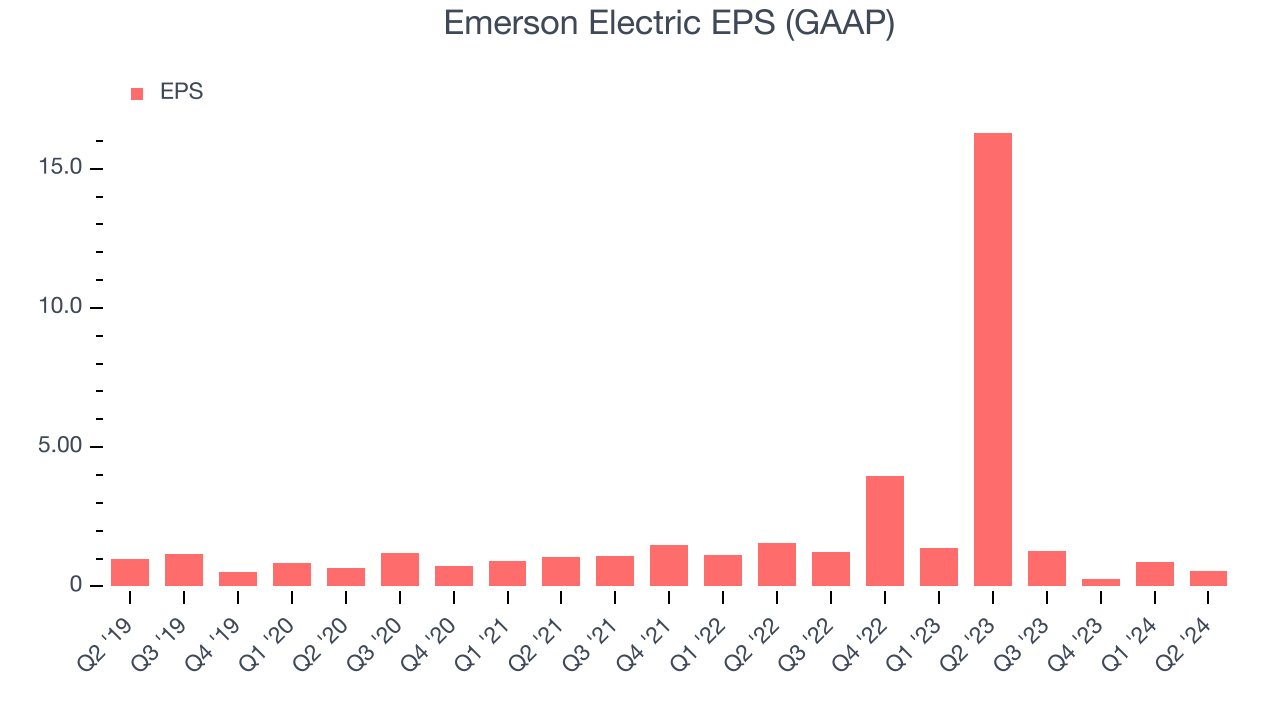Engineering and automation solutions company Emerson (NYSE:EMR) fell short of analysts' expectations in Q2 CY2024, with revenue up 11% year on year to $4.38 billion. It made a GAAP profit of $0.57 per share, down from its profit of $16.30 per share in the same quarter last year.
Is now the time to buy Emerson Electric? Find out by accessing our full research report, it's free.
Emerson Electric (EMR) Q2 CY2024 Highlights:
- Revenue: $4.38 billion vs analyst estimates of $4.44 billion (1.3% miss)
- EPS: $0.57 vs analyst expectations of $0.92 (38.2% miss)
- Gross Margin (GAAP): 52.8%, up from 50.5% in the same quarter last year
- Market Capitalization: $61.66 billion
"Emerson delivered another strong quarter, with solid underlying orders growth and with profitability and cash flow both exceeding expectations," said Emerson President and Chief Executive Officer Lal Karsanbhai.
Founded in 1890, Emerson Electric (NYSE:EMR) is a multinational technology and engineering company providing solutions in the industrial, commercial, and residential markets.
Internet of Things
Industrial Internet of Things (IoT) companies are buoyed by the secular trend of a more connected world. They often specialize in nascent areas such as hardware and services for factory automation, fleet tracking, or smart home technologies. Those who play their cards right can generate recurring subscription revenues by providing cloud-based software services, boosting their margins. On the other hand, if the technologies these companies have invested in don’t pan out, they may have to make costly pivots.
Sales Growth
A company’s long-term performance can give signals about its business quality. Even a bad business can shine for one or two quarters, but a top-tier one tends to grow for years. Emerson Electric struggled to generate demand over the last five years as its sales were flat. This is a tough starting point for our analysis. 
We at StockStory place the most emphasis on long-term growth, but within industrials, a half-decade historical view may miss cycles, industry trends, or a company capitalizing on catalysts such as a new contract win or a successful product line. Emerson Electric's annualized revenue growth of 6.8% over the last two years is above its five-year trend, but we were still disappointed by the results.
This quarter, Emerson Electric's revenue grew 11% year on year to $4.38 billion, falling short of Wall Street's estimates. Looking ahead, Wall Street expects sales to grow 7.3% over the next 12 months, a deceleration from this quarter.
Today’s young investors won’t have read the timeless lessons in Gorilla Game: Picking Winners In High Technology because it was written more than 20 years ago when Microsoft and Apple were first establishing their supremacy. But if we apply the same principles, then enterprise software stocks leveraging their own generative AI capabilities may well be the Gorillas of the future. So, in that spirit, we are excited to present our Special Free Report on a profitable, fast-growing enterprise software stock that is already riding the automation wave and looking to catch the generative AI next.
Operating Margin
Operating margin is a key measure of profitability. Think of it as net income–the bottom line–excluding the impact of taxes and interest on debt, which are less connected to business fundamentals.
Emerson Electric has been a well-oiled machine over the last five years. It demonstrated elite profitability for an industrials business, boasting an average operating margin of 18.6%. This result isn't surprising as its high gross margin gives it a favorable starting point.
Analyzing the trend in its profitability, Emerson Electric's annual operating margin rose by 5.7 percentage points over the last five years, showing its efficiency has meaningfully improved.

This quarter, Emerson Electric generated an operating profit margin of 24.2%, up 2.2 percentage points year on year. Since its gross margin expanded more than its operating margin, we can infer that leverage on its cost of sales was the primary driver behind the recently higher efficiency.
EPS
We track the long-term growth in earnings per share (EPS) for the same reason as long-term revenue growth. Compared to revenue, however, EPS highlights whether a company's growth was profitable.
Sadly for Emerson Electric, its EPS declined by 7.9% annually over the last five years while its revenue was flat. However, its operating margin actually expanded during this timeframe, telling us non-fundamental factors affected its ultimate earnings.

Like with revenue, we also analyze EPS over a shorter period to see if we are missing a change in the business. For Emerson Electric, its two-year annual EPS declines of 25% show its recent history was to blame for its underperformance over the last five years. These results were bad no matter how you slice the data.
In Q2, Emerson Electric reported EPS at $0.57, down from $16.30 in the same quarter last year. This print missed analysts' estimates. Over the next 12 months, Wall Street expects Emerson Electric to grow its earnings. Analysts are projecting its EPS of $2.98 in the last year to climb by 38.2% to $4.11.
Key Takeaways from Emerson Electric's Q2 Results
We struggled to find many strong positives in these results. Its EPS missed and its revenue fell short of Wall Street's estimates. Overall, this was a bad quarter for Emerson Electric. The stock traded down 2.5% to $105.03 immediately after reporting.
Emerson Electric may have had a tough quarter, but does that actually create an opportunity to invest right now? When making that decision, it's important to consider its valuation, business qualities, as well as what has happened in the latest quarter. We cover that in our actionable full research report which you can read here, it's free.
